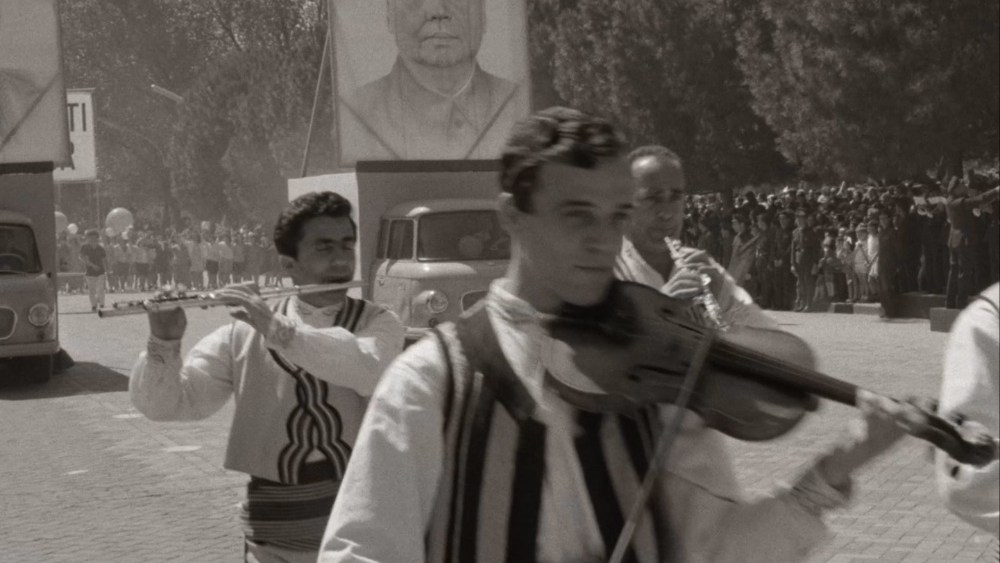Listen to the article
Documentary Unveils Power of Propaganda Through Albania’s Communist Archives
Roland Sejko’s documentary “A State Film” offers a mesmerizing examination of propaganda’s visual power through meticulously curated footage from Albania’s communist era. Currently screening in the main competition at the Ji.hlava International Documentary Film Festival in the Czech Republic, the film explores how images shaped public perception under dictator Enver Hoxha’s regime.
Sejko, who serves as head of the editorial department for Italy’s Cinecitta Luce, brings his expertise as a professional archivist to this compelling project. “I’ve been working for several years with propaganda film archives—first with Istituto Luce Cinecitta, and also with the archives of the Albanian communist regime,” Sejko explains. “Both contain thousands of films created to construct a political narrative, often with striking cinematic ambition.”
The documentary builds upon Sejko’s previous work, “The Image Machine of Alfredo C.,” which debuted at the 2021 Venice Film Festival. While researching that hybrid film about an Italian cameraman who documented both Mussolini’s fascist propaganda and later communist Albania, Sejko recognized an untapped opportunity.
“During its making, I realized that the vast Albanian film archive—and the central figure of Enver Hoxha—had never been narrated exclusively through their own images,” says the director.
The influence of Soviet filmmaking is evident throughout the Albanian footage. “The first Albanian camera operators were trained by Soviet masters—starting with Roman Karmen, the legendary chronicler of revolutions and wars,” Sejko notes. This training created a visual language that transcended national borders across communist states.
“There was never a manual for the propaganda cameraman, no written rulebook for how to film a regime. Yet something invisible governed their images,” observes Sejko. “A First of May parade filmed in communist Albania looks strikingly similar to one filmed in Moscow or Bucharest or Sofia in the same years.”
The documentary spans post-WWII Albania, showcasing familiar propagandistic imagery—worker heroes, traditional folk dancers, and enormous portraits of Hoxha alongside Soviet leader Stalin and Yugoslav dictator Tito paraded through streets. The footage highlights Albania’s industrial aspirations while also revealing Hoxha’s paranoia through scenes of defensive bunker construction and testing—a reminder of the hundreds of thousands of concrete bunkers scattered throughout Albania as protection against presumed Western aggression.
Some of the most disturbing scenes show dogs and guinea pigs apparently being sacrificed to test defenses against potential gas attacks, all while patriotic songs serve as a constant backdrop.
What sets “A State Film” apart is Sejko’s innovative approach to sound design. He removed the original heavy-handed narration, replacing it with ambient sounds—wind, birdsong, footsteps on unpaved roads.
“In official propaganda films—newsreels, documentaries, parades—the narrator’s voice was not descriptive but prescriptive: it told viewers what to think,” Sejko explains. “Replacing it with another commentary, even a critical one, would have meant repeating the same mechanism.”
By creating a realistic soundscape with “footsteps, murmurs, creaks, silences,” Sejko restores a sense of physicality to the images and transforms sound into a narrative tool. This approach allows viewers to engage more critically with the footage rather than being directed how to interpret it.
The documentary gains additional depth through footage from Hoxha’s personal archive, showing the dictator away from the cheering crowds, often driving his favorite black Mercedes. These private moments create a striking contrast that, according to Sejko, symbolizes “the loneliness and isolation of power.”
Critics have praised “A State Film” for demonstrating “how the archive is not just a repository of images, but a tool for interpreting and rewriting history.” The documentary transcends Albanian history to examine how visual propaganda functions universally in political contexts and shapes collective memory—a theme with unsettling relevance as similar techniques continue to be employed in modern political messaging.
Verify This Yourself
Use these professional tools to fact-check and investigate claims independently
Reverse Image Search
Check if this image has been used elsewhere or in different contexts
Ask Our AI About This Claim
Get instant answers with web-powered AI analysis
Related Fact-Checks
See what other fact-checkers have said about similar claims
Want More Verification Tools?
Access our full suite of professional disinformation monitoring and investigation tools




12 Comments
As an archivist, I’m intrigued by the filmmaker’s expertise in working with propaganda film archives. The curation of these materials must be a delicate and important task.
I look forward to seeing how the documentary navigates the complexities of presenting this archival footage in a thoughtful and impactful way.
Fascinating look at the power of propaganda through Albania’s cinematic archives. I’m curious to learn more about how the visual narratives shaped public perception under the Hoxha regime.
The documentary seems like an insightful exploration of the cinematic ambition behind communist propaganda films.
The convergence of cinema and propaganda is a fascinating subject. I wonder how the filmmaker aims to balance critical analysis with an appreciation for the cinematic artistry, even in service of a repressive regime.
Exploring the visual language of propaganda could shed light on how it appeals to and shapes human psychology and decision-making.
It’s commendable that the filmmaker is bringing this important historical material to light. Examining the techniques and impact of propaganda is crucial for understanding how it can be used to manipulate and control populations.
I hope the documentary encourages critical thinking about the role of media and visual narratives in shaping political and social realities, both past and present.
Propaganda can be a powerful tool, but it’s concerning to see how it was used to manipulate public opinion in Albania. I hope this film provides a balanced and critical examination of that history.
It’s important to understand the mechanisms of propaganda, both historical and contemporary, so we can be better equipped to recognize and resist it.
The Albanian propaganda archives must be a rich and complex trove of material. I’m eager to see how the filmmaker navigates the ethical and artistic challenges of presenting this content to modern audiences.
Exploring the cinematic ambition behind propaganda films could offer valuable insights into the psychology and techniques used to influence public opinion.